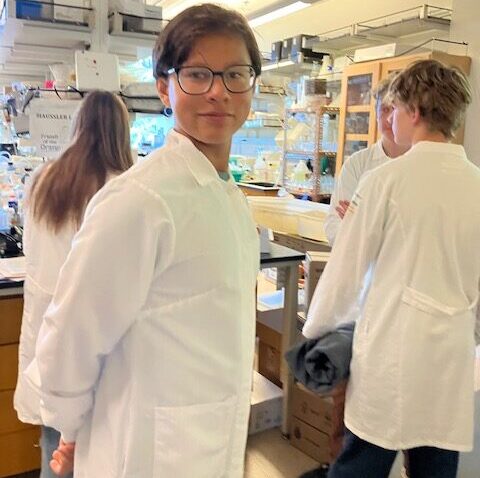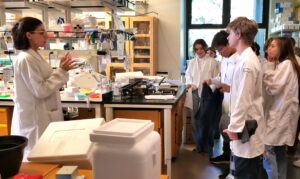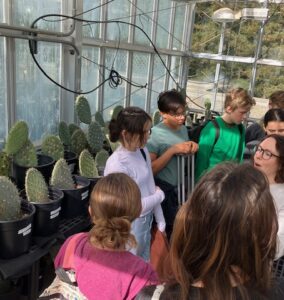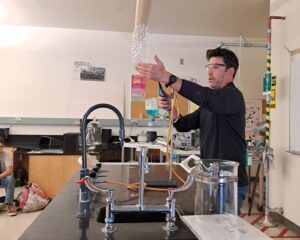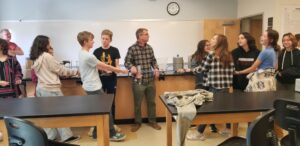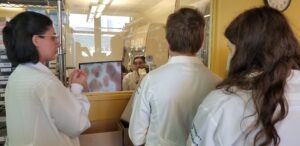 Recently, Mount Madonna School (MMS) seventh grade students visited science classrooms and research laboratories on the campuses of Cabrillo College and the University of California, Santa Cruz (UCSC), to expose them to science and research underway, and for an “early” glimpse into institutions of higher education.
Recently, Mount Madonna School (MMS) seventh grade students visited science classrooms and research laboratories on the campuses of Cabrillo College and the University of California, Santa Cruz (UCSC), to expose them to science and research underway, and for an “early” glimpse into institutions of higher education.
At UCSC, the students visited three working science labs and talked with professors and graduate students about their research. The first, a stem cell lab, used brain organoids, brain cells derived from stem cells, to study brain function. In the second lab, the students learned about research on the effects of environmental toxins on the human body. Students also visited the Environmental Studies Department and learned about living solar panels made from cacti.
“Creating energy from cacti? Charley, one of the graduate students at UCSC, told us that researchers were trying to make ‘living’ solar panels from a particular type of cacti,” said student Giavanna Iacocca. “She explained that bird strikes on reflective solar panels are a significant problem, and through photosynthesis and the cacti, they may be able to avoid this. Although their research is still in a testing stage, it’s so interesting to consider what may someday be possible.”
said student Giavanna Iacocca. “She explained that bird strikes on reflective solar panels are a significant problem, and through photosynthesis and the cacti, they may be able to avoid this. Although their research is still in a testing stage, it’s so interesting to consider what may someday be possible.”
 “While visiting researchers at UCSC, students learned that scientists have to solve problems they have never seen before, and they often get stuck or frustrated along the way,” commented teacher John Welch, who accompanied the students and middle school science teacher Hilary Alvarado on these field trips. “In their MMS coding class following the trip, the seventh graders were given robots they hadn’t worked with before and had to figure out how to make them do useful tasks. They experienced the combination of excitement, creativity and frustration that scientists often go through, and they did really well.”
“While visiting researchers at UCSC, students learned that scientists have to solve problems they have never seen before, and they often get stuck or frustrated along the way,” commented teacher John Welch, who accompanied the students and middle school science teacher Hilary Alvarado on these field trips. “In their MMS coding class following the trip, the seventh graders were given robots they hadn’t worked with before and had to figure out how to make them do useful tasks. They experienced the combination of excitement, creativity and frustration that scientists often go through, and they did really well.”
“I liked hearing about the interesting study of brain organoids at UCSC,” said student Nolan McKibbin, “and learning how with technology you can see different parts of a brain firing.”
“It was really cool to see the electron microscopes, and hear that researchers use these to look at how different parts of the organoid are firing and the frequency,” commented classmate Felix Alvarado.
Alvarado.
In December at Cabrillo College, students toured chemistry and physics classrooms, where they observed and participated in several visual science demonstrations, including seeing marshmallows “squished” by air pressure and gasses less dense than the surrounding air lit on fire in the chemistry classroom.
“The chemistry demonstration at Cabrillo was really cool to watch,” said student Eva Melton. “Besides seeing the effects on the marshmallows, when we asked the professor what would happen to a balloon in the vacuum chamber, he said ‘let’s try it!” I liked that he let us ask questions and expand on things.”
 “At Cabrillo, the science teacher lit the element Strontium on fire and it made sparks!” commented student Leyla Klosinski. “Strontium is white, but when it burns, it turns red!”
“At Cabrillo, the science teacher lit the element Strontium on fire and it made sparks!” commented student Leyla Klosinski. “Strontium is white, but when it burns, it turns red!”
The students met with members of Women in Science and Engineering (WiSE), watched engineering student presentations and visited the science, technology, engineering and mathematics (STEM) lab, where college students study and seek out tutoring. As a “tasty” addition to their “college-life experience,” students had lunch at the Cabrillo cafeteria.
“We really paid attention to the chemistry presentation at Cabrillo,” said student Cadence Barr. “It was so interesting and easier to understand because we could see it up close, as it happened, and not just read about it.”
Contact: Leigh Ann Clifton, director of marketing & communications,
Nestled among the redwoods on 380 acres, Mount Madonna School (MMS) is a diverse learning community dedicated to creative, intellectual, and ethical growth. MMS supports its students in becoming caring, self-aware, discerning and articulate individuals; and believes a fulfilling life includes personal accomplishments, meaningful relationships and service to society. The program, accredited by the California Association of Independent Schools (CAIS) and Western Association of Schools and Colleges (WASC), emphasizes academic excellence, creative self-expression and positive character development. Located on Summit Road between Gilroy and Watsonville. Founded in 1979.

